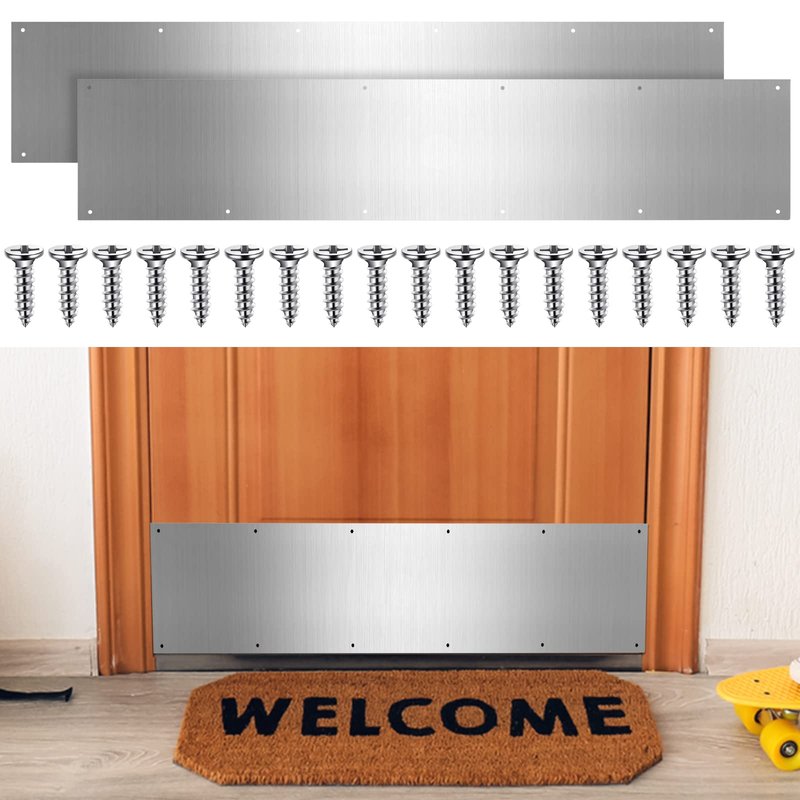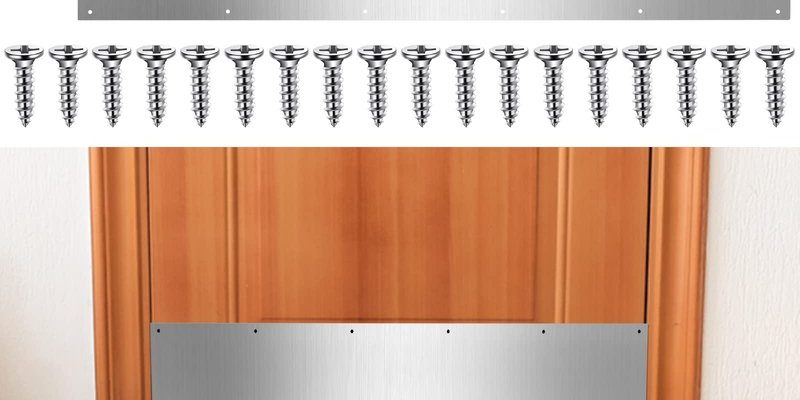
Here’s the thing: you don’t need to be a pro, own a workshop, or even have much experience to repair minor scratches on an aluminum kick plate, whether it’s a standard Schlage, Baldwin, or a no-name model from the hardware store. With the right approach, you can smooth out the worst of those marks and keep it looking nearly as good as new. So, if you’re standing there eyeing your battered kick plate and thinking “How hard can it be?”—you’re in the right place.
Let me explain the tools, steps, and tricks you’ll need to get those minor scratches under control without making things worse. There’s a bit of technique, some patience, and a few household items that will save the day. Even if you’ve never tackled a scratch repair before, you’ll be surprised at how approachable it actually is.
Why Aluminum Kick Plates Scratch So Easily
First, let’s talk about why these kick plates seem to attract scratches in the first place. Aluminum is popular for kick plates because it’s lightweight, affordable, and resists rust. But honestly, it’s also a pretty “soft” metal compared to steel. That means even normal daily wear—like sneakers, keys, or pet nails—can leave scuff marks or shallow grooves.
You might be wondering if all aluminum kick plates are alike. Some have a powder-coated or anodized finish, which helps resist deep gouges and gives a bit of extra armor. Others, especially brushed or satin-finish plates, show every little mark. Shiny, mirror-style plates can be even fussier; one swipe of a key or dog paw and—yep, there’s a line staring back at you.
Here’s a tip: the way you repair a scratch depends on both the depth of the scratch and the finish of the aluminum. Minor, surface-level scratches? Those are fair game for DIY fixes. Deep gouges or bent metal? That’s a job for a pro or, honestly, a replacement plate. This guide will focus on nicks and light scratches you can actually do something about at home.
What You’ll Need: Tools and Supplies for Scratch Repair
Before you start, it’s important to gather everything so you’re not running in and out mid-job. Thankfully, you don’t need a whole hardware store. Most small scratches on an aluminum kick plate can be handled with everyday items. Here’s what I recommend:
- Clean, soft cloths (microfiber is ideal)
- Mild soap or dish detergent
- Water (preferably lukewarm)
- Non-abrasive aluminum polish (like Mothers or Brasso)
- Fine-grit sandpaper (at least 800–1000 grit, sometimes 2000 grit for extra-fine work)
- Steel wool (
- Masking tape (optional, to protect nearby paint or surfaces)
- Gloves (if you want to keep hands clean)
Honestly, some people swear by toothpaste as a gentle abrasive, and yes, it can work in a pinch for ultra-light scratches! But for best and safest results, stick with products designed for metal. Also, don’t grab that heavy-duty kitchen scrubber—those can actually make things worse.
Step-by-Step: How to Fix Minor Scratches on an Aluminum Kick Plate
Here’s where the real magic happens. Every step matters, so don’t rush, and always test in a small, less-visible spot first to avoid surprises.
-
Start with a clean surface:
Use a microfiber cloth and mild soap mixed with water to gently wipe down the kick plate. Remove all dust, dirt, and grease—scrubbing a dirty surface just grinds grit deeper into the scratches. -
Assess the scratches:
Look at the kick plate in good light. Can you catch your fingernail on the scratch? If not, it’s shallow and can usually be fixed with polish or fine steel wool. Deeper scratches might need gentle sanding. -
Polish shallow scratches:
Apply a small amount of aluminum polish to a soft cloth. Rub it gently, following the grain of the metal (not in circles). Use light pressure—overdoing it can leave swirls. Buff with a clean cloth to check your progress. -
Tackle stubborn scratches:
If polish alone doesn’t do the trick, use -
Wipe and inspect:
Clean off all residue with a damp cloth. Dry it thoroughly to spot any spots you missed. Sometimes scratches “disappear” when wet, so be sure it’s dry before calling it done.
Always follow the *grain* of the aluminum. Going against it will make the scratch stand out even more.
You might be surprised how forgiving aluminum can be if you’re patient. Most light scratches will melt away or at least become way less obvious.
How to Avoid Making Scratches Worse
Here’s what nobody tells you: a botched repair can draw more attention than the original scratch. So, what should you avoid?
- Never use coarse sandpaper or rough steel wool. These will gouge the aluminum and leave big, obvious marks that are much harder to fix.
- Skip harsh cleaners or bleach. These can react with the aluminum and leave ugly stains or dull patches.
- Don’t press too hard. Light pressure is key. You’re smoothing, not trying to sand down a deck chair.
- Avoid circular motions. Always polish and sand in the direction of the metal’s grain. Circles leave swirl marks (especially on brushed finishes).
Something else to watch for: if your kick plate is painted (uncommon, but it happens), don’t use abrasive methods at all. Stick to gentle cleaning and polishing, or consult the manufacturer.
Comparing DIY Repair vs. Replacement
You might be wondering, “Is all this really worth the hassle, or should I just get a new kick plate?” Fair question. It depends on a few things:
- Depth of damage: Superficial scratches respond well to DIY fixes. Deep gouges, dents, or warped plates usually require replacement.
- Finish type: Brushed or satin finishes hide repairs better than mirror-polished aluminum, where every touch shows.
- Time and cost: DIY repair mostly costs your time and a few dollars in supplies. Replacement can be pricey, especially for custom sizes or designer brands like Baldwin or Emtek.
If your kick plate has sentimental value (maybe you installed it yourself, or it matches your house’s style), it’s worth trying a repair first. For badly battered plates, replacing is usually easier.
*There’s no shame in swapping out a kick plate if it’s past saving. But a few minutes with polish and patience can stretch its life surprisingly far.*
Extra Tips for a Lasting, Low-Maintenance Finish
Once your aluminum kick plate is looking better, a little routine care can keep it that way longer. Here’s how I handle my own:
- Clean gently, but regularly: Just a quick wipe-down every week prevents grit from building up and scratching the finish.
- Add a thin coat of wax: Car wax or furniture wax (unscented, clear) creates a protective layer that helps repel scuffs and makes cleaning easier next time.
- Watch out for “troublemakers”: Pets that scratch at the door, heavy boots, or clutter can all add up. A doormat or a well-placed sign (“No paws on the door!”) can help protect the plate.
- Inspect for loose screws or shifting: Sometimes scratches get worse if the plate wiggles and rubs against the door. A 30-second check now and then can prevent trouble.
It doesn’t take much to keep your Schlage or generic aluminum kick plate looking crisp—just a few easy habits.
When to Call a Pro (Or Replace the Plate)
Sometimes, despite your best efforts, a scratch is too deep, or the repair leaves a cloudy patch on the aluminum. If you’re not happy with the results, here are your options:
- Local metal restoration services: Some pros can polish or even re-anodize aluminum, restoring a like-new look. Best for pricey, decorative kick plates.
- Order a replacement: Most brands (Schlage, Baldwin, Emtek) sell kick plates in standard sizes online or at hardware stores. Swapping them out is usually a simple “unscrew and replace” job.
- Upgrade to a more scratch-resistant finish: If you’re tired of constant upkeep, consider a stainless steel plate or a powder-coated aluminum version next time.
If you go the pro route, ask for an estimate first. Sometimes the cost doesn’t make sense unless the kick plate is part of a high-end door or a historic home.
Final Thoughts: Keeping Your Kick Plate Looking Its Best
Fixing minor scratches on an aluminum kick plate isn’t rocket science, but it does take a steady hand and a bit of patience. Like most home fixes, it’s more about technique than brute force. Take your time, use gentle products, and always work with the grain. Most of the time, you’ll be able to smooth out those little annoyances and give your entryway a quick glow-up.
Honestly, a shiny, scratch-free kick plate gives a front door a surprising lift—like polishing your shoes before a big meeting. With these steps, you don’t just cover up the problem; you learn how your home works and pick up a satisfying new skill. And next time someone notices your door looking sharp, you’ll have an easy fix ready for any new scuff that appears.
